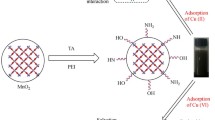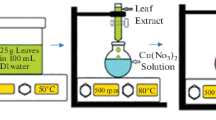Abstract
Industrial dyeing produces highly polluting wastewater and threatens the environment. Effective treatment of dyeing wastewater is a crucial step to prevent toxic chemicals from entering receiving waters. This study aimed to assess a modified attapulgite (ATP)-based adsorbent for dyeing wastewater purification by introducing chitosan (CTS) and titanium dioxide (TiO2) into the adsorbent material named TiO2/CTS/ATP. It was found that after modification, the adsorbent showed a lower hydrophilicity, as demonstrated by an increase in the water contact angle from 9.1° to 42°, which could reduce the water adsorption tendency and potentially facilitate contaminants adherence. The modification also led to a significantly increased specific surface area of 79.111 m2/g from 3.791 m2/g and exhibited more uniform and smaller particle size (reduced from 3.99 to 2.52 μm). When the TiO2/CTS/ATP adsorbent was applied to the adsorption of Congo red solution, the adsorption efficiency was observed to reach to 97.6% at the dosage of 0.5 g/L. Furthermore, the combination of adsorption and ultrafiltration was able to achieve 99% Congo red removal. Adsorption pretreatment prior to the ultrafiltration also enabled to reduce membrane fouling, increased the reversible membrane fouling, and resulted in a considerably lower transmembrane pressure as compared with the direct ultrafiltration filtration system.









Similar content being viewed by others
Data availability
All data generated is already in the manuscript.
References
Abdel-Karim A, El-Naggar ME, Radwan EK, Mohamed IM, Kenawy ER (2020) High-performance mixed-matrix membranes enabled by organically/inorganic modified montmorillonite for the treatment of hazardous textile wastewater. Chem Eng J 405:126964
Abdulhameed AS, Jawad AH, Mohammad A-T (2019a) Synthesis of chitosan-ethylene glycol diglycidyl ether/TiO 2 nanoparticles for adsorption of reactive orange 16 dye using a response surface methodology approach. Bioresour Technol 293:122071
Abdulhameed AS, Mohammad A-T, Jawad AH (2019b) Application of response surface methodology for enhanced synthesis of chitosan tripolyphosphate/TiO 2 nanocomposite and adsorption of reactive orange 16 dye. J Clean Prod 232:43–56
Aimar P, Bacchin P (2010) Slow colloidal aggregation and membrane fouling. J Membr Sci 360:70–76
Alardhi SM, Albayati TM, Alrubaye JM (2020) A hybrid adsorption membrane process for removal of dye from synthetic and actual wastewater. Chem Eng Process Process Intensif 157:108113
Chatterjee S, Chatterjee S, Chatterjee BP, Guha AK (2007) Adsorptive removal of Congo red, a carcinogenic textile dye by chitosan hydrobeads: binding mechanism, equilibrium and kinetics. Colloids Surf A Physicochem Eng Asp 299:146–152
Chen W, Mo J, Du X, Zhang Z, Zhang W (2019) Biomimetic dynamic membrane for aquatic dye removal. Water Res 151:243–251
Cheng X, Liang H, Ding A, Tang X, Liu B, Zhu X, Gan Z, Wu D, Li G (2017) Ferrous iron/peroxymonosulfate oxidation as a pretreatment for ceramic ultrafiltration membrane: control of natural organic matter fouling and degradation of atrazine. Water Res 113:32–41
Chon K, Cho J (2016) Fouling behavior of dissolved organic matter in nanofiltration membranes from a pilot-scale drinking water treatment plant: an autopsy study. Chem Eng J 295:268–277
Cieśliński JT, Krygier KA (2014) Sessile droplet contact angle of water–Al 2 O 3 , water–TiO 2 and water–Cu nanofluids. Exp Thermal Fluid Sci 59:258–263
Djellabi R, Ghorab MF, Cerrato G, Morandi S, Gatto S, Oldani V, Michele AD, Bianchi CL (2014) Photoactive TiO2 –montmorillonite composite for degradation of organic dyes in water. J Photochem Photobiol A Chem 295:57–63
Dong Y, Su Y, Chen W, Peng J, Zhang Y, Jiang Z (2011) Ultrafiltration enhanced with activated carbon adsorption for efficient dye removal from aqueous solution. Chin J Chem Eng 19:863–869
Feng T, Zhang F, Wang J, Wang L (2012) Application of chitosan-coated quartz sand for Congo red adsorption from aqueous solution. J Appl Polym Sci 125:1766–1772
Field RW, Pearce GK (2011) Critical, sustainable and threshold fluxes for membrane filtration with water industry applications. Adv Colloid Interface Sci 164:38–44
Guerranti C, Martellini T, Perra G, Scopetani C, Cincinelli A (2019) Microplastics in cosmetics: environmental issues and needs for global bans. Environ Toxicol Pharmacol 75-79
Hammami A, Charcosset C, Amar RB (2017) Performances of continuous adsorption-ultrafiltration hybrid process for AO7 dye removal from aqueous solution and real textile wastewater treatment. Journal of Membrane Science & Technology
Hassan H, Salama A, El-ziaty AK, El-Sakhawy M (2019) New chitosan/silica/zinc oxide nanocomposite as adsorbent for dye removal. Int J Biol Macromol 131:520–526
Jawad AH, Abdulhameed AS, Najwa N, Malek A, Alothman ZA (2020) Statistical optimization and modeling for color removal and COD reduction of reactive blue 19 dye by mesoporous chitosan-epichlorohydrin/kaolin clay composite. Int J Biol Macromol 4218-4230
Karthikeyan KT, Nithya A, Jothivenkatachalam K (2017) Photocatalytic and antimicrobial activities of chitosan-TiO2 nanocomposite. Int J Biol Macromol 104:1762–1773
Ku Y, Huang Y-H, Chou Y-C (2011) Preparation and characterization of ZnO/TiO2 for the photocatalytic reduction of Cr(VI) in aqueous solution. J Mol Catal A Chem 342–343:18–22
Lin J, Ye W, Baltaru M-C, Tang YP, Bernstein NJ, Gao P, Balta S, Vlad M, Volodin A, Sotto A, Luis P, Zydney AL, Bruggen BV (2016) Tight ultrafiltration membranes for enhanced separation of dyes and Na2SO4 during textile wastewater treatment. J Membr Sci 514:217–228
Liu Y, Huang J, Wang X (2008) Adsorption isotherms for bleaching soybean oil with activated attapulgite. J Am Oil Chem Soc 85:979–984
Mansor ES, Ali H, Abdel-Karim A (2020) Efficient and reusable polyethylene oxide/polyaniline composite membrane for dye adsorption and filtration. Colloid Interfac Sci Commun 39:100314
Nidheesh PV, Zhou M, Oturan MA (2018) An overview on the removal of synthetic dyes from water by electrochemical advanced oxidation processes. Chemosphere 197:210–227
Nie J, Xu J, Du X, Wang Z, Tan W (2018) Research on the preparation of TiO2/CTS/ATP and its adsorption capability for Cr(VI). Industrial Water Treatment 38:28–31
Nodehi R, Shayesteh H, Kelishami AR (2020) Enhanced adsorption of Congo red using cationic surfactant functionalized zeolite particles. Microchem J 153:104281
Pan D, Fan Q, Fan F, Tang Y, Zhang Y, Wu W (2017) Removal of uranium contaminant from aqueous solution by chitosan@attapulgite composite. Sep Purif Technol 177:86–93
Paz A, Carballo J, Pérez MJ, Domínguez JM (2017) Biological treatment of model dyes and textile wastewaters. Chemosphere 181:168–177
Peng L, Chen B, Zhao Y (2020) Quantitative characterization and comparison of bentonite microstructure by small angle X-ray scattering and nitrogen adsorption. Constr Build Mater 262:120863
Salameh S, Scholz R, Seo JW, Mädler L (2014) Contact behavior of size fractionated TiO2 nanoparticle agglomerates and aggregates. Powder Technol 256:345–351
Samsami S, Mohamadi M, Sarrafzadeh MH, Rene ER, Firoozbahr M (2020) Recent advances in the treatment of dye-containing wastewater from textile industries: Overview and perspectives. Process Saf Environ Prot 143:138–163
Selvaraj V, Swarna Karthika T, Mansiya C, Alagar M (2021) An over review on recently developed techniques, mechanisms and intermediate involved in the advanced azo dye degradation for industrial applications. J Mol Struct 1224:129195
Setthaya N, Chindaprasirt P, Yin S, Pimraksa K (2017) TiO2-zeolite photocatalysts made of metakaolin and rice husk ash for removal of methylene blue dye. Powder Technol 313:417–426
Shahanaz P, Kumar BB, Asadur RM, Hafizur RM, Shahyaz AM, Raes UM (2019) Study on adsorption of Congo red onto chemically modified egg shell membrane. Chemosphere 236:124326
Siripatrawan U, Kaewklin P (2018) Fabrication and characterization of chitosan-titanium dioxide nanocomposite film as ethylene scavenging and antimicrobial active food packaging. Food Hydrocoll 84:125–134
Wang H, Wang X, Ma J, Xia P, Zhao J (2017) Removal of cadmium (II) from aqueous solution: a comparative study of raw attapulgite clay and a reusable waste–struvite/attapulgite obtained from nutrient-rich wastewater. J Hazard Mater 329:66–76
Wang H, Sun Y, Wu Y, Tu W, Wu S, Yuan X, Zeng G, Xu ZJ, Li S, Chew JW (2019) Electrical promotion of spatially photoinduced charge separation via interfacial-built-in quasi-alloying effect in hierarchical Zn 2 In 2 S 5 /Ti 3 C 2 (O, OH) x hybrids toward efficient photocatalytic hydrogen evolution and environmental remediation. Appl Catal B Environ 245:290–301
Wei Y, Cui M, Ye Z, Guo Q (2020) Environmental challenges from the increasing medical waste since SARS outbreak. J Clean Prod
Wongso V, Chen CJ, Razzaq A, Kamal NA, Sambudi NS (2019) Hybrid kaolin/TiO2 composite: effect of urea addition towards an efficient photocatalyst for dye abatement under visible light irradiation. Appl Clay Sci 180:105158
Xiaoduo L, Jiefu T, Yuanyuan L, Ningfei S, Shu M, Yong X, Ziyu C (2019) Enhanced dyes adsorption from wastewater via Fe3O4 nanoparticles functionalized activated carbon. J Hazard Mater 373:397–407
Yu W, Graham N, Yang Y, Zhou Z, Campos LC (2015) Effect of sludge retention on UF membrane fouling: the significance of sludge crystallization and EPS increase. Water Res 83:319–328
Zhang J, Xie S, Ho Y-S (2009) Removal of fluoride ions from aqueous solution using modified attapulgite as adsorbent. J Hazard Mater 165:218–222
Zhang J, Wang L, Zhang G, Wang Z, Xu L, Fan Z (2013) Influence of azo dye-TiO2 interactions on the filtration performance in a hybrid photocatalysis/ultrafiltration process. J Colloid Interface Sci 389:273–283
Zhou Q, Gao Q, Luo W, Yan C, Ji Z, Duan P (2015) One-step synthesis of amino-functionalized attapulgite clay nanoparticles adsorbent by hydrothermal carbonization of chitosan for removal of methylene blue from wastewater. Colloids Surf A Physicochem Eng Asp 470:248–257
Zhou Y, Yang Y, Liu G, He G, Liu W (2020) Adsorption mechanism of cadmium on microplastics and their desorption behavior in sediment and gut environments: the roles of water pH, lead ions, natural organic matter and phenanthrene. Water Res 184:116209
Funding
This research was jointly supported by the National Natural Science Foundation of China (51808131) and Natural Science Foundation of Guangdong Province, China (2018A030310569).
Author information
Authors and Affiliations
Contributions
Zhihong Wang: Experimental design; Writing, original draft preparation. Zekun Wu: Sample analysis; Graph editing. Xujun Zhi: Reactor operation and sample analysis, Data curation. Wanling Tan and Tianfu Tu: Sample analysis. Jinxu Nie: Reactor design, Experimental design. Xing Du: Reactor design; Writing, reviewing; Editing. Yunlong Luo: English editing; Writing, reviewing.
Corresponding authors
Ethics declarations
Ethics approval and consent to participate
Not applicable.
Consent for publication
All authors read and approved the final manuscript. All authors are fully aware of this manuscript and have permission to submit the manuscript for possible publication
Competing interests
The authors declare no competing interests.
Additional information
Responsible Editor: Tito Roberto Cadaval Jr
Publisher’s note
Springer Nature remains neutral with regard to jurisdictional claims in published maps and institutional affiliations.
Supplementary Information
ESM 1
(DOCX 422 kb)
Rights and permissions
About this article
Cite this article
Wang, Z., Wu, Z., Zhi, X. et al. TiO2/CTS/ATP adsorbent modification and its application in adsorption-ultrafiltration process for dye wastewater purification. Environ Sci Pollut Res 28, 59963–59973 (2021). https://doi.org/10.1007/s11356-021-13933-3
Received:
Accepted:
Published:
Issue Date:
DOI: https://doi.org/10.1007/s11356-021-13933-3




